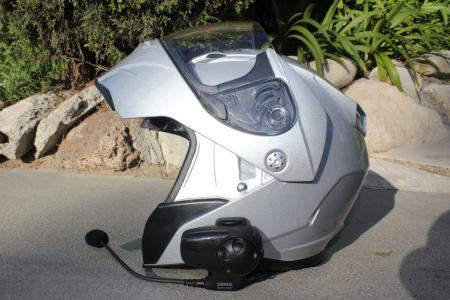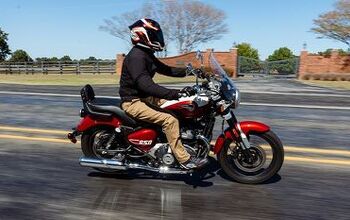Sena SMH10 Bluetooth Headset and Intercom Review
Rider-to-rider communication is nothing new. Devices of one sort or another have been around for decades now. Early communicators focused mainly on rider to passenger communication and later progressed to offer communication capabilities for multiple riders. The systems revolved around transceivers that could allow riders to talk to each other, assuming they were all on the same channel. The challenges have always been range, clarity and battery life.
As technology advances, all three issues have progressively improved. And with the advent of Bluetooth technology, the range of a communicator’s functionality have expanded greatly.
And that’s where Sena comes in. Its SMH10 Bluetooth Headset and Intercom is the company’s latest offering in communicating devices for the motorcycle market (Sena also produces other, non-motorcycle-related communication products). The SMH10 allows Bluetooth intercom communication with up to three other SMH10 units, with a claimed range of up to 900 yards. And because it features Bluetooth v2.1 technology, it can also be paired up with an MP3 player, GPS navigation and a cell phone (assuming all three are Bluetooth capable).
Each package contains the headset main unit, a speaker-microphone clamp unit (with an Allen wrench), a stereo jack (to plug a music device directly into the SMH10 if it isn’t Bluetooth capable), a glued mounting surface adaptor (which can be used instead of the clamp unit), a microphone sponge, Velcro pads, and a DC charger for use at home. A neat feature we found is the included 12-volt charger for use on motorcycles equipped with an on-board outlet. This allows for direct charging of the unit while it’s in use. Great idea, Sena. Should you forget the 12v charger, Sena claims talk time of 12 hours with a standby time of 10 days.
Installation is rather straightforward, though it’ll vary slightly depending on the type of helmet. The included speaker and microphone setup works best on three-quarter helmets or modulars, though it can accommodate full-face lids if the boom microphone is contorted just right. Usually this means removing the chin curtain of the helmet if it’s so equipped. Sena also sells different speaker/microphone packages that would be better suited to those who prefer to wear full-face helmets. The most appropriate being the earbud kit with wired microphone.
With the correct kit in hand, installation is a matter of connecting the base plate to the helmet with either the clamp or glue, connecting the head unit to the base plate, and routing the speakers in a comfortable position within the helmet, directly inline with the ear canal. After that, simply tuck the speaker wires underneath the helmet liner or padding.
Once fully assembled, we did notice our helmets were a skosh heavier on our heads, but that’s to be expected and it really wasn’t bothersome once we got used to it. Sena is proud of the fact that the SMH10 only has two buttons which control all of the unit’s functions. Simply put, the large round dial (the Jog Dial) controls intercom functions, while the small button (Phone Button) behind it is used for phone calls.
Tapping the two buttons simultaneously for one second activates the unit, while holding down the Jog Dial for varying amounts of time allows you to sync with other units or devices. While riding, the SMH10 has a hierarchy of devices it will transmit. Music devices can play in the background, but will be interrupted by GPS devices, which will then be cut by intercom communication, with a phone call trumping all others.
Tapping the Jog Dial starts and stops an intercom communication and is the default mode, though there is a function to initiate the intercom just by speaking loudly into the microphone. The microphone is sensitive to voice recognition over wind noise. Meaning the system won’t be fooled into thinking a conversation is trying to take place by errant wind noise. With that said, and with the volume set to the highest setting (by simply twisting the Jog Dial), I was able to hear Editor Duke’s voice loud and clear at speeds ranging from 30 mph to 80 mph, despite wearing earplugs. There’s no getting around the fact that wind noise will be present in the conversation, but the unit does contain noise-suppressing technology to limit the distraction from the wind while talking.
We were also impressed by the unit’s range; Kevin and I were able to hear each other perfectly despite an approximate quarter-mile separation between us on the highway. We can definitely see this feature being handy when riding in a group if one member gets left behind accidentally. Though it’s worth noting that range is limited to line-of-sight communication. At a reasonable distance, range is severely hampered — and in some cases ended — once a significant obstruction puts a rider out of sight. We see this being an issue for riders trying to communicate with each other in the canyons.
Still, sound quality is perfectly acceptable when in range. When connected to a Bluetooth capable phone, sound quality for the rider still comes in loud and clear. Our tester at home on the other end of the line did complain about noticeable wind noise, though noted that my voice was still easily discernible. Not that we condone having phone conversations while riding, but it’s good to know it’s possible should there be an important call one must take while riding. And, depending on the phone, the SMH10 can even play back your phone’s ringtones.
GPS directions, too, are easily heard through the speakers, and while we didn’t get a chance to connect an MP3 player to the unit, based on the rest of our findings, we have no doubt its sound quality is superb as well. And according to the manual, scrolling through songs is simply done on the Jog Dial as well.
All told, we were impressed by the SMH10 range of functionality. It’s a compact unit that performs many features we’ve come to expect from communicators. And the Bluetooth functionality just increases its range of flexibility. The two buttons are simple to use with gloved hands and the manual clearly explains how to use them.
A single SMH10 will set you back $219, while a dual pack goes for $399. To learn more about the SMH10 or to order one, go to the Sena website: http://www.senabluetooth.com/.
Related Reading
Cardo Scala Rider Q2 Bluetooth Communicator Review
More by Troy Siahaan
































Comments
Join the conversation